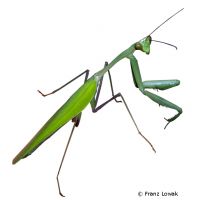Giant Indian Mantis (Hierodula membranacea)
| Giant Indian Mantis Hierodula membranacea | |
|---|---|
| Name | Giant Indian Mantis |
| Name Lat. | Hierodula membranacea |
| Family | Mantids |
| Family lat. | Mantidae |
| Order | Praying Mantids |
| Order lat. | Mantodea |
| Origin | Southeast Asia |
| Habitat | Rainforest |
| Diet | Flying insects |
| Humidity | 50-70 % |
| Behavior | Predatory |
| Keeping | Individual |
| Care Level | Easy |
| Housing | Semi-humid terrarium |
| Breeding | Moderately difficult |
| Life Span | 8-10 months |
| Protection | No |
| Metric Units | |
| Size | 7-10 cm |
| Temperature Day | 25-30 °C |
| Temperature Night | 20-24 °C |
| Housing Size | 30 x 30 x 50 cm |
| US Units | |
| Size | 2.8"-4" |
| Temperature Day | 77-86 °F |
| Temperature Night | 68-75 °F |
| Housing Size | 10" x 10" x 20" |
Distribution and habitat
The distribution range of the diurnal Indian Giant Mantis stretches from India through Sri Lanka, Thailand and the southern parts of China to Java. There they inhabit shrubs and trees of the tropical forests.
Maintenance
For a female an insectarium of 30 x 30 x 50 cm (L x W x H), for a group of up to 5 males 40 x 40 x 60 cm, can be recommended as a guideline. An insectarium with a cover made of gauze or a fine metal grid is best suited, which should be placed in a quiet, place without sunlight.
You will need an insectarium not too densely structured with finger-thick climbing branches (hiding places, privacy screens), climbing plants and pieces of bark, with a cork back wall, as well as a small, shallow drinking vessel with water gel or a cotton trough. Artificial or live plants (e.g. Ficus pumila, Scindapsus aureus) can be used for decoration. The substrate of coconut fiber, vermiculite or sand-loam-peat mixture should always be kept slightly moist. Daily, the insectarium should be finely sprayed with water inside (humidity), but a rain or mist system is better. Waterlogging should be avoided at all costs.
| Temp. day: 25-30 °C | Temp. night: 22-24 °C | Humidity: 50-70 |
The lighting duration should be max. 12 hrs. Light sources that also produce the necessary heat are ideal.
Diet
They are predatory and seize even very large prey, preferably flying insects, at lightning speed with their spiny tentacles. The food supply should consist of crickets, house crickets, flies (Drosophila) and grasshoppers, small butterflies but also small arachnids and cockroaches, etc.. It is important to regularly add minerals and vitamins (e.g. by dusting the feeders). The quality of the feeders can be enhanced by feeding overripe fruit and honey water. A few days before, during and after molting, they refuse to eat. No predatory feeders (e.g. crickets) should be left in the insectarium during molting, as during this time the animals are unprotected and may become prey themselves. A varied diet promotes health and prevents deficiency symptoms.
Reproduction and breeding
Adult females are slightly larger and stronger than the slimmer males. The males have 8, the females only 6 abdominal segments.
After mating, which lasts several hours, the female lays several egg packages (oothecae) after a few days. At a temperature of 25-28 °C and a humidity of about 60%, up to 100 or more larvae hatch after 4-6 weeks. They should be fed immediately with small fruit flies or microheims so that they do not eat each other (cannibalism).
After imaginal molting, females live about 10 months, males about 8 months.
Important
Prior to mating, a large food animal should be offered to the female to reduce the risk of her eating the male. It is recommended to keep females singly.
They have very good camouflage due to their body shape and coloration as well as their often long-lasting immobility and are very similar to a leaf (leaf mimesis).
For molting they hang upside down in the branches or on the lattice cover and slide out of their old cover. Therefore they need at least one body length of free space below them.
Before purchasing, an insectarium should be prepared that meets the species-specific needs. Good ventilation without drafts is necessary, as well as equipment for measuring temperature and humidity. The lighting must correspond to the day-night rhythm appropriate for the species and must be installed in such a way that the animals cannot injure themselves. The insectarium should be locked in such a way that neither unauthorized persons can open it nor the animals can escape. Special attention must be paid to thorough hygiene and contamination must be removed regularly.
Further literature can be found in your pet store.
References
Text: Serena Werle; Image: Franz Lowak
Source: ENGELMAN & LANGE (2011): Zootierhaltung - Tiere in menschlicher Obhut: Wirbellose, Verlag Harri Deutsch; HENKEL & SCHMIDT (2010): Taschenatlas Wirbellose für das Terrarium, Verlag Ulmer
